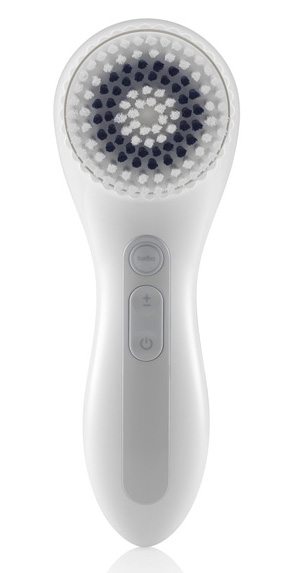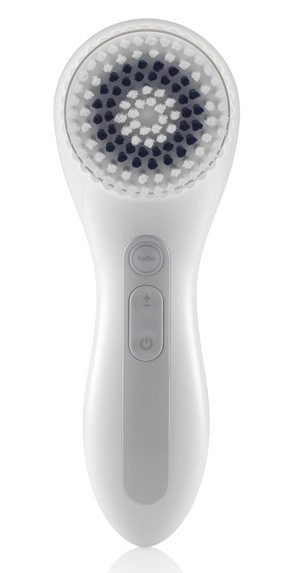Ever wondered why the beauty world is so obsessed with the Clarisonic?

Dr. Robb Akridge, co-founder of Clarisonic, is sitting at his desk at the company’s headquarters in Seattle, holding a small rotary brush to a section of nude pantyhose that’s been smoothed out across a rectangular piece of plastic. He’s demonstrating the action of a competing device, and the sight of the nylon being aggressively twisted and spun makes for a compelling visual. And while it certainly gives the impression that it’s doing something when applied to the face, according to Akridge, this kind of single direction movement pulls at the skin. “Is it safe? Yeah, it’s safe,” he says. “Is it really sonic? No. It’s not what we call sonic technology.”
Akridge would know. He was one of the inventors of Sonicare, which harnessed sonic technology in a toothbrush. That’s also what sets Clarisonic apart from other electric facial brushes on the market (its 40-plus patents keep it that way too). Instead of spinning or vibrating, the brush head oscillates, moving more than 300 times per second. You can imagine pores being shaken silly as they’re coerced into expelling excess oil, makeup and even air-pollution micro-particles, which is why the company asserts that the device cleans skin in a way that’s unmatched by hands. And, as the thinking goes, if your skin is unsullied, it will drink up any products you apply afterward.
Scientific claims aside, when the product went to market in 2004, it was a challenge to get people on board. “When we first launched, no one knew they needed a brush to cleanse their face,” recalls Akridge. “They all thought they were doing a good enough job with their hands or washcloth. We had to educate people on why they needed it, so that was the first hurdle.” But in a society obsessed with cleanliness, the forward-thinking idea of adding a gizmo to one’s beauty routine didn’t take long to catch on. A shout-out on Oprah’s Favorite Things, followed by word of mouth in the beauty industry, ignited a frenzy, and the Clarisonic swiftly developed a devout following among hardcore skincare fanatics. (Seriously, search it on the beauty website Into the Gloss and you’ll see how many times it gets name-checked.)
Eager to differentiate itself from the competition, the brand is launching Smart Profile, a version that allows a more customized cleanse. For its original design, the Clarisonic was programmed to operate at a frequency that was neither aggressive nor weak. The only adjustment you could make was changing the brush head to Sensitive, Deep Pore or Acne to suit your needs. “Now, we’ve taken that one frequency out of the handle and put the brain in the brush head,” says Akridge. The “smart” brushes included (one for face, one for body) come with specific instructions on speed, frequency and time spent on an area—for example, longer and more vigorously on the T-zone areas but less so on the cheeks. And its cleansing power? It has now jumped to 11 times better than manual. (Eat it, long-wear makeup.)
And despite the launch of countless other devices, which join the ranks of a growing category, Akridge insists they’re not the least bit concerned about it. Instead, the thing they want to lure people away from isn’t found on a store shelf. “Our competition are these two things: our hands,” he says, palms up.








